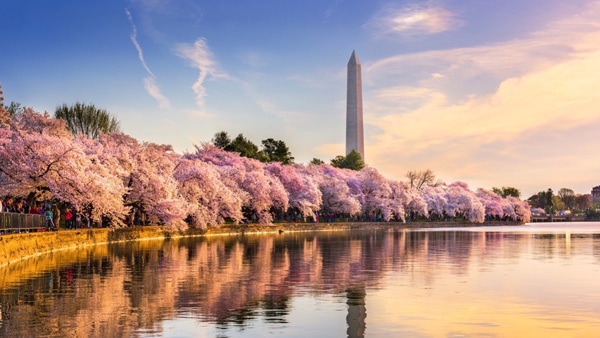By Ambassador Callista L. Gingrich
Every spring, more than 1 million people flock to Washington, D.C. to experience the beauty of thousands of Japanese cherry trees in full bloom and to take part in the annual National Cherry Blossom Festival.
Today, thousands of Japanese cherry trees surround the Tidal Basin in the heart of our nation’s capital and symbolize our important diplomatic relationship with Japan. The City of Tokyo’s gift of cherry trees in 1912, embodied the hope for a mutual friendship that, decades later, would come to fruition.
Mrs. Eliza Ruhamah Scidmore’s advocacy efforts in the late 19th century played a significant role in bringing Japanese cherry trees to Washington, D.C.
A world traveler, prolific travel writer, and newspaper correspondent, 29-year-old Scidmore ventured to Japan for the first time, where she saw what she would later describe as, “the most beautiful thing in the world – the Japanese cherry tree.”
After returning to D.C. in 1885, she made it her mission to bring the delicate, enchanting beauty of the Japanese cherry tree to the United States.
For more than two decades, Scidmore pressed to have cherry trees planted on newly reclaimed parkland near the Potomac River but had no success. She tried to convince every Superintendent of Public Buildings and Grounds of her vision for a “future fairyland,” but instead, her requests “were of no avail, no matter how fervent, long or often repeated.”
In 1908, Scidmore joined forces with Dr. David Fairchild, who was an official with the U.S. Department of Agriculture. Fairchild had successfully planted 100 Japanese cherry trees on his hillside property in Chevy Chase, Maryland and became an advocate for planting these flowering trees in the Washington area.
Fairchild supported Scidmore’s idea for planting Japanese cherry trees on the reclaimed land of Potomac Park. Scidmore and Fairchild devised a plan for acquiring and covering the costs of the trees. In 1909, Scidmore wrote to First Lady Helen Herron Taft – whom she previously met in Japan — asking for her help.
At the time, the first lady was working to beautify Potomac Park. Familiar with the cherry trees from her time living in Japan, First Lady Taft responded enthusiastically to Scidmore’s request.
When the Japanese got word that the United States intended to plant cherry trees in the national capital, famed Japanese chemist Dr. Jokichi Takamine asked if the first lady would be willing to accept an additional donation of trees, an offer she gratefully accepted. In the name of the City of Tokyo, Mayor Yukio Ozaki, sent 2,000 cherry trees to the United States.
For Ozaki, the trees were a thank you gift to the U.S. for its role in negotiating an end to the Russo-Japanese War as well as a symbol of friendship. Though Ozaki held office during a time when Japan was “primarily dominated by soldiers and all-out nationalists,” he was a staunch advocate for warm relations between the U.S. and Japan.
On January 6, 1910, the Japanese cherry trees arrived in Washington, D.C. However, they were discovered to be infested with insects and nematodes and had to be destroyed.
Determined to see the gesture through to completion, Mayor Ozaki and the Tokyo City Council sent a second donation of more than 3,000 cherry trees from 12 varieties to the United States. The new trees arrived in Washington on March 26, 1912.
In a simple ceremony the following day, First Lady Taft and the Japanese ambassador’s wife, Viscountess Chinda, planted two cherry trees on the Tidal Basin’s northern bank. Over the next eight years, the remaining trees were planted around the Tidal Basin and in East Potomac Park.
While on his deathbed in the 1950s, Ozaki wrote a poem reflecting on the magnificence that still today captivates Washington as the cherry trees bloom:
“As I gaze at cherry blossom in my garden
From my sickbed, I recall
The Potomac in spring.”
As people from across America and around the world come to Washington, D.C. to marvel at the cherry blossoms, let us reflect on the determination of Eliza Ruhamah Scidmore – and how one person’s persistence can create enduring beauty for generations to come.


